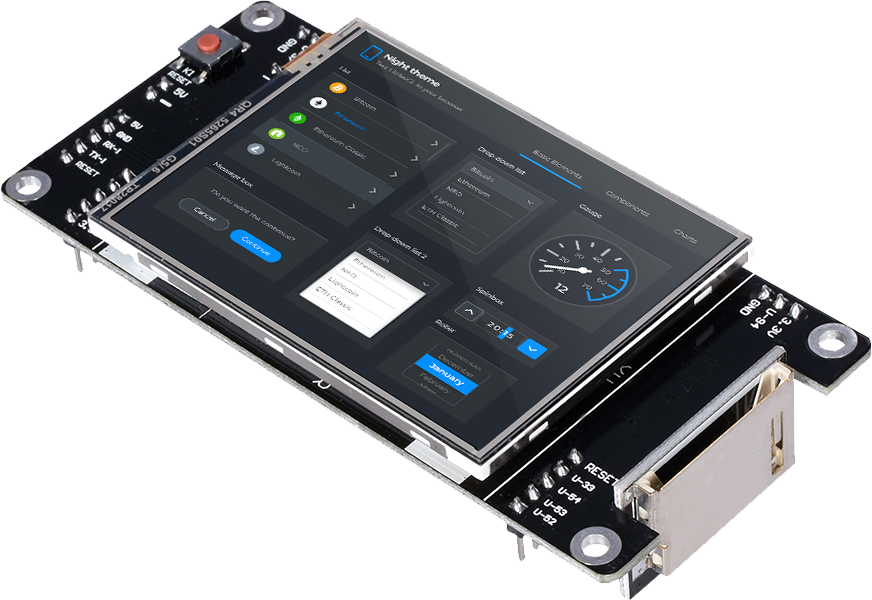LVGL provides everything you need to create a Graphical User Interface (GUI) on embedded systems with easy-to-use graphical elements, beautiful visual effects and low memory footprint.
LVGL is compatible with #![no_std] environments by default.
In order to build the lvgl project you will need the following system dependencies to be installed:
$ sudo apt install build-essential llvm clang
If you want to build the examples, then you will need to install SDL2 as well.
$ sudo apt install libsdl2-dev
Edit your Cargo.toml file dependencies with:
$ cargo add lvgl
The build requires the environment variable bellow to be set:
DEP_LV_CONFIG_PATH: Path to the directory containing thelv_conf.hheader file used for configuration of LVGL library.- (Optional)
LVGL_FONTS_DIR: Directory for custom fonts generated for use in LVGL. See the documentation for usage. - (Optional)
LVGL_INCLUDE: C headers to include during the build if using thedriversfeature, comma-separated. The default is/usr/include,/usr/local/include. - (Optional)
LVGL_LINK: C libraries to link in during the build if using thedriversfeature, comma-separated. The default isSDL2.
We recommend the lv_conf.h file to be in your project's root directory. If so, the command to build your project would be:
$ DEP_LV_CONFIG_PATH=`pwd` cargo buildWe make use of bindgen for generating the bindings to LittlevGL at build time. There is a problem in cargo when building
for no_std, so we need to use a workaround to build "lvgl-rs". The mainstrem issue in cargo is being tracked at
rust-lang/cargo#7915.
$ DEP_LV_CONFIG_PATH=`pwd` cargo build -Zfeatures=build_depThe unsafe_no_autoinit feature must also be enabled when building for baremetal targets. See its documentation in Cargo.toml for notes on usage.
A global allocator for Rust leveraging the
LVGL memory allocator is provided, but not enabled
by default. Can be enabled by the feature lvgl_alloc. This will make all dynamic memory to be allocated by LVGL
internal memory manager.
Hint for macOS users: Before you run the demos you need to make sure you have libsdl installed on your machine. To install it, use HomeBrew:
$ brew install sdl2This project contains examples that can run in a desktop simulator.
First, make sure to pull lvgl-rs submodules:
$ git submodule init
$ git submodule update Then run the demo example:
$ DEP_LV_CONFIG_PATH=`pwd`/examples/include cargo run --example demo --features="alloc"The bindings are still in development. There are many features of LVGL that needs to be exposed by lvgl-rs. In
this section you can check what is implemented at the moment.
List of LVGL features that impacts the library usage in general.
- Displays: We use
embedded_graphicslibrary to draw to the display, along withlv_drivers. You can uselvgl-rswith any of theembedded_graphicssupported displays, and those supported bylv_drivers. Note:lv_driverssupport is currently experimental. - Events: You can listen and trigger events in widget objects.
- Styles: You can set styles in any exposed object. We are still missing the possibility of defining global base styles.
- Input Devices: Input devices supported by
lv_driverscan be used, and custom handlers can be specified forembedded_graphics. Currently, only pointer input devices are supported. Note:lv_driverssupport is currently experimental. - Fonts: All fonts built-in to LVGL can be used on nightly Rust if the
nightlyfeature is enabled. Custom fonts can also be encoded into a C file (see the documentation on thefontmodule). - Animations: Creating basic animations is supported entirely from Rust.
- Images
- File system
- Tasks
Widgets currently implemented might have some missing features. If the widget you want to use is not exposed or is missing a feature you want to make use, please send a Pull Request or open an issue.

